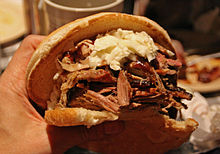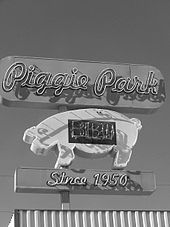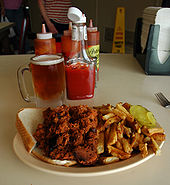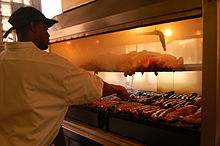Barbecue
![]()
The title of this article is ambiguous. For other meanings, see Barbecue (disambiguation).
![]()
This article is not sufficiently supported by evidence (e.g., anecdotal evidence). Information without sufficient evidence may be removed soon. Please help Wikipedia by researching the information and adding good evidence.
The largely essayistic article is not sufficiently supported by single references and bibliographical references in the encyclopedic sense and needs revision anyway (because it is outdated).--Rote4132 (Discussion) 02:35, 21. Mar. 2020 (CET)
Barbecue (often abbreviated as BBQ) is a cooking method in which large pieces of meat are slowly cooked in a pit or special barbecue smokers at a moderate temperature in the hot exhaust air of a wood fire. The word can refer to the cooking method itself as well as the food prepared with it or an event at which this food is prepared. Barbecue is especially widespread in the southern states of the USA. Commonly prepared meats include pork (especially pork shoulders, spare ribs, or whole hogs), beef (especially brisket), mutton, and poultry. Larger cuts of meat, such as shoulders, are separated from the bone in small pieces after preparation and served chopped up on a sandwich. Barbecue sauces vary greatly by region, generally ranging from "dry" preparations with spices only, to vinegar, mustard, or tomato-based sauces, to sauces consisting primarily of ketchup and syrup.
Barbecue is not only an important element of Southern cuisine, but like any form of food culture, it also has an important function in the formation of a sense of identity. It is an activity that is practiced relatively across classes in the South of the USA and therefore constitutes something common, but also allows for pronounced regional and local differences.
In a broader sense, barbecue is often used as a synonym for grilling, but differs significantly in terms of cooking method. Much more closely related to barbecue are jerk, a common food in the Caribbean, and the Mexican barbacoa.

Pulled-Pork-Sandwich
Barbecue and grilling
In English and increasingly also in German, barbecue is used synonymously with the word grilling. The differences are clear: barbecuing takes place directly over the embers at 200 to 300 degrees Celsius. The comparatively small pieces of meat (steak, chops, hamburgers, etc.) take a maximum of half an hour to cook. With barbecue, on the other hand, the meat is cooked by hot smoke, the temperature of which is around 100 to 130 degrees Celsius. The much larger pieces of meat (whole beef brisket, whole pork shoulder, whole pig) can thus take up to 24 hours before they are cooked.
In areas where barbecue in the narrower sense is widespread, there is also a clear conceptual distinction between barbecue and grilling. In North Carolina, the word cookout - meaning "to cook outdoors" - is often used for grilling over glowing coals, while other US regions speak of grilling or broiling (with the heat in broiling coming from above or from the side). In British English, however, the verb to grill usually denotes heat from above, and the word barbecue denotes German Grillen, while barbecue in the American sense is largely unknown. While the Webster dictionary gives barbecue as the only spelling allowed, in everyday life the spelling of the dish is almost as varied as its preparation; common synonyms include barbique, barbeque, bar-b-que, bar-b-cue, bar-b-q, BBQ, cue, or simply Q.
History
Origin
Originally, the word comes from the Mexican-Spanish word barbacoa, which is derived from the Taíno word buccan and used to refer to a wooden framework on which the Taino prepared meat over an open fire. The first written reference to barbacoa is found in Gonzalo Fernández de Oviedos De la historia General y Natural de las Indias from 1526.
The method of slowly heating meat in smoke was widespread throughout the Caribbean and along the mainland coast to Brazil at the time of the Spanish conquest of the Americas. Thus, barbacoa was already known to Bernal Díaz del Castillo, who wrote the True History of the Conquest of New Spain, an eyewitness account of the Spanish conquest in the years from 1519 to 1521. However, Díaz del Castillo used the term to refer to meat that was roasted in pits in what is now Mexico.
The close connection with the Caribbean also shows that the Spanish, French and English words for the buccaneers of the Caribbean - bucanero, boucanier and buccaneer - can also each be traced back to the word origin buccan from the Taino. As jerk, similar preparation methods have also survived in Central America and the Caribbean. In Mexico, whole goats are cooked over a fire at low temperatures, while in Cuba a whole pit-smoked pig is considered a traditional Christmas dinner.
The Spanish were involved in the creation of today's barbecue by introducing pigs and thus pork to the New World. In the Oxford English Dictionary, the word "barbecue" appears for the first time in 1661, but still refers to the wooden framework. A few decades later, the meal alone was already meant when, for example, Benjamin Lynde mentioned barbecues in 1733 or later George Washington and Thomas Jefferson in their records.
Even though the first mentions of barbecue in the area of today's USA come from Virginia, no strong barbecue tradition was able to establish itself there in the long run. The "cradle of barbecue" is therefore considered to be the Carolinas (North Carolina and South Carolina), where the strongest local differences in the way of preparation have also developed. Like many dishes of Southern cuisine, barbecue is influenced by African-American cuisine (soul food). Many of the cooks were slaves who came to the Southern states via the Caribbean, where they gained knowledge of Caribbean cuisine and spices.
Social foundations
Barbecues as social events evolved from slaughter parties. Because barbecues were always held outdoors, including in public, they quickly became the focus of neighborhood gatherings, family gatherings, and church celebrations. Beginning around 1800, large barbecues on Southern plantations quickly began to become important social events. In the Southern epic Gone with the Wind, for example, the plume of smoke and the smell of pork and mutton symbolize the hospitality of the Twelve Oaks plantation.
More deeply rooted in the people and often a gathering of people of many classes was barbecue as an event of a Christian congregation and especially at major political events. For many decades, every politician in the South held barbecues both for fundraising and as victory celebrations. In 1923, for example, for the inauguration of Oklahoma Governor Jack C. Walton, a barbecue featuring 289 cattle, 70 hogs, 36 sheep, 2540 rabbits, 134 opossums, 15 deer, 1427 chickens, and one antelope.
Early barbecues in cities were often prepared in backyards in specially dug holes or inverted bathtubs. One of the reasons for the strong roots of barbecue in the South after the Civil War was the relative poverty there. Pork was comparatively easy to obtain: In addition to domestic pigs, numerous feral hogs had lived in the woods since the 16th century. Many owners also let their animals roam the countryside semi-wild and find their own food. The method of low temperature cooking for many hours has the advantage of tenderizing even tough meat. Smoking was a method of creating flavor without having to resort to expensive spices. Barbecue thus originated primarily as a food of poor people who received only the less desirable parts of the pig, and used the method to also smoke ribs, shoulders, or feet until tender. In the Southern states, this meant that barbecue was always closely related to and rooted in the African American community.
Commercial providers are establishing themselves
Commercial barbecue restaurants began to establish themselves in the late 19th, early 20th century. In Owensboro, Kentucky, Henry Green opened a commercial barbecue stand in 1890. The first all-barbecue restaurant in Lexington, North Carolina, can be traced to 1920, when Warner Stamey was probably the first to combine hushpuppy with barbecue. Leonard's, one of the first restaurants in Memphis, opened in 1922 and borrowed heavily in technique from the city's backyard barbecuers.
As the automobile spread across the United States, barbecue stands sprang up along the roads. Barbecue, along with hot dogs, became the first successful food for the automobile traveler, with barbecue stands establishing themselves primarily in the South and Southwest. As early as 1921, J. G. Kirby, with the financial backing of R. W. Jackson, founded the Pig Stands Company, which by 1934 was operating over 100 Pig Stands serving America's Motor Lunch. The locations away from enclosed settlements lent themselves well to the large pits and heavy smoke associated with cooking.
However, as more national fast food chains became established, barbecue increasingly lost ground in the market. Thus, barbecue never succeeded in becoming standardized. Unlike hamburgers, for example, regional differences in barbecue are pronounced; no one succeeded in establishing an "all-American barbecue". Individual attempts, such as that of the Love's chain in the late 1970s with a California-Texas version, failed, as did the Luther's chain in the 1980s in its attempt to establish a Texas barbecue nationally. Moreover, preparation is lengthy and labor-intensive and difficult to standardize. As part of a trend toward faster and faster food and preparation, barbecue lost market share shortly after its boom. Pig Stands, for example, did not survive the Second World War as a chain.
National and international dissemination
Barbecue is particularly popular in the southern states and spread from there to the rest of the USA from the end of the 19th century through migrating African Americans from the southern states. The migratory paths that emerged are similar to those of blues and jazz, as both barbecue and music culture were carried by similar populations. These then often brought the style of their homeland with them. Thus, immigrants from Texas and Oklahoma came to California in particular, while various styles from the Deep South coalesced in Kansas City. Chicago and Detroit, on the other hand, received immigrants from the Mississippi Delta and Memphis, which led not only to the emergence of the Chicago blues, but also to a lively barbecue culture in these cities. The northeastern U.S., on the other hand, was especially attractive to immigrants from the coastal states of the Carolinas and Georgia, so these BBQ varieties are most common there. As with blues and jazz, however, barbecue has changed over the course of this migration.
While barbecue joints exist all over the U.S., they are much more prevalent in the Southern states. For example, the Yellow Pages of Atlanta, itself more of a barbecue hinterland within the Southern states, knew of nearly 30 restaurants specializing in barbecue, while the Boston Yellow Pages had 26 pages on eateries with none specializing in barbecue, and even Manhattan had only one restaurant that also offered barbecue. Similarly, the prototypical signet of a laughing pig was only found in ads in Southern phone books Memphis, Tennessee alone, on the other hand, has over 100 restaurants specializing in barbecue, Kansas City about 90. In strongholds like Memphis, even chains like Tops Bar-B-Q exist that successfully sell barbecue as early as the morning. With the exception of Memphis and Kansas City, barbecue has a much greater presence in rural areas than in cities. Atlanta, the unofficial capital of the South, has comparatively few joints and, for example, eliminated barbecue from its catering program for the 1996 Olympics in favor of hamburgers. Cities known throughout the U.S. for their near-idolatry of barbecue are Lexington, North Carolina (population about 19,000); Goldsboro, North Carolina (39,000); Owensboro, Kentucky (55,000); and Lockhart, Texas (11,000).
Barbecue restaurants today
Barbecue restaurants tend to be small businesses that rarely have branches. A certain barbecue myth holds that individual styling, referring to barbecue's formerly low social origins, is essential. Even in less affluent areas, they still seem comparatively run-down, despite the forced improvements that stricter sanitation laws have brought. The lifestyle magazine Southern Living, more middle- and upper-class oriented in its readership, even went so far as to speak of a barbecue primitive architectural style as a sure indicator of the best BBQ restaurants: "They're often barbecue joints, recognizable by the torn fly screens in the door, the scratched and dented furniture, cough syrup calendars, shelves of potato chips, sometimes a jukebox, and always a bar that gives it the ambiance of a beer tap that's just over the border of a booze-free county.“.
Even the well-known Arthur Bryant's in Kansas City is in an area of abandoned houses and lonely streets; in the restaurant, cold neon lights shine on what appear to be ancient plastic tables, while the Rendezvous in Memphis is distinguished by a plethora of old pictures, posters, maps, street signs and masses of other decorative items. It's loud, busy, but friendly, with waiters often working there for several decades. More unusual, however, is the barbecue stand at Mount Zion Missionary Baptist Church in Huntsville, Texas, which enjoys nationwide popularity and causes long lines outside the church every Sunday.
After barbecue took a strong social upswing since the 1990s and it became possible to earn comparatively a lot of money as the owner of a barbecue joint, the restaurant landscape diversified. Still rarely appearing with branches, large, successful restaurants also began to establish themselves in barbecue centers, far less quaint and more oriented toward conventional dining, but still considered iconic eateries. In recent years, successful restaurants like Corky's in Memphis, which specifically caters to a middle-class clientele, have been able to expand into other locations and even FedEx barbecue US-wide, or like Oklahoma Joe's in Kansas City, which also makes barbecue smokers that in turn dominate the festival scene. While various Memphis restaurants are trying to capitalize on the fact that FedEx has its worldwide headquarters at the Memphis airport, none has been as successful as Corky's, which is now one of the best-known barbecue restaurants in the US.
Festivals
As a result of the popularity of barbecue, an extensive competitive culture has developed and is booming, especially in recent years. The season runs from the American Royal in Kansas City in the fall to Memphis in May in the spring. It goes from local competitions to U.S.-wide championships. Major barbecue championships hold elimination contests across the southern states. Several 10,000 visitors often turn out for the finals weekend. The winning teams often draw on corporate sponsorships that allow them to pay for the equipment and to attend the competition.
The first festival of this kind was the World Championship Bar-B-Que Contest, which has been held since 1973 as part of the Houston Livestock Show in the parking lot of the Houston Astrodome. About 350 teams compete there and 150,000 people attend, but most of them probably want to go to the Livestock Show. Largest organizers of barbecue-only competitions are the Kansas City Barbecue Association, the International Barbecue Cookers Association, which operates out of Texas, and, as an individual competition, the World Championship Barbecue Cooking Contest, nationally the best-known part of Memphis in May. The Kansas City Barbecue Association alone provided over 6,000 judges in 2004, overseeing 177 elimination contests for the American Royal in Kansas City. In all, a half-dozen major competitions are held somewhere in the U.S. every weekend during the season. Owensboro has hosted the largest barbecue gathering in Kentucky since the 1980s with the annual International Bar-B-Q Festival. The Lexington Barbecue Festival is the largest festival in the coastal states, drawing up to 150,000 people.
Today, the world's largest exclusive barbecue festival takes place every year on the banks of the Mississippi River in Memphis. Several hundred teams compete in the World Championship Barbecue Cooking Contest, part of the Memphis in May folk festival. They compete in 15 to 20 categories for prizes worth a total of about $90,000, most of it provided by sponsors, of course. In addition, it is also a folk festival with, for example, Elvis doubles, politicians on the campaign trail or - typical of the Bible Belt - missionary Christians. Also in Memphis, although significantly smaller, there is also a kosher barbecue festival in August since 1988, which combines the influence of a relatively large Jewish Orthodox community with the barbecue hype on the banks of the Mississippi.
BBQ Trails in the USA
US BBQ trails are a great way to learn about the different characteristics of local barbecue. The most famous trails include the Kansas Barbecue Trail, the Texas Barbecue Trail, the North and South Carolina BBQ Trail, the Southern BBQ Trail, the Memphis and Tennessee BBQ Trail and the Kentucky Barbecue Trail.
Barbecue worldwide
In recent decades, barbecue has also spread outside the USA. A major role is played by competitions in which different teams compete, and which now take place in many parts of the world. There is a world federation and national barbecue associations. In the 2008 Memphis Barbecue Competition in May, teams from Estonia, Norway and Belgium also qualified. However, while barbecue is part of the everyday culture of almost the entire population in parts of the southern states, in Europe it is still considered unusual, practiced by individuals, and often still requires an explanation of the concept to potential eaters.
In the USA itself, the effects of the competitions are ambivalent. Many prize winners and winners later go into business for themselves and establish restaurants or at least sell sauce under their name. In doing so, they help to keep the esteem of the craft high in the trade and set a comparatively high standard. On the other hand, competition barbecue is relatively homogeneous and oriented towards proven recipes for success regardless of the local factor: the competitions thus generally raise the level of everyday barbecue, but also contribute to its homogenisation and the loss of local identity.

Map of Payne's Bar-B-Q - a famous restaurant in Memphis

Although barbecue never won out over hamburgers in the fast food market, numerous barbecue restaurants did spring up in the 20th century

Restaurant Barbecue: Pulled Pork at Arthur Bryant's in Kansas City.

Restaurant in Chicago with a large selection of different varieties on the Smoker
Search within the encyclopedia